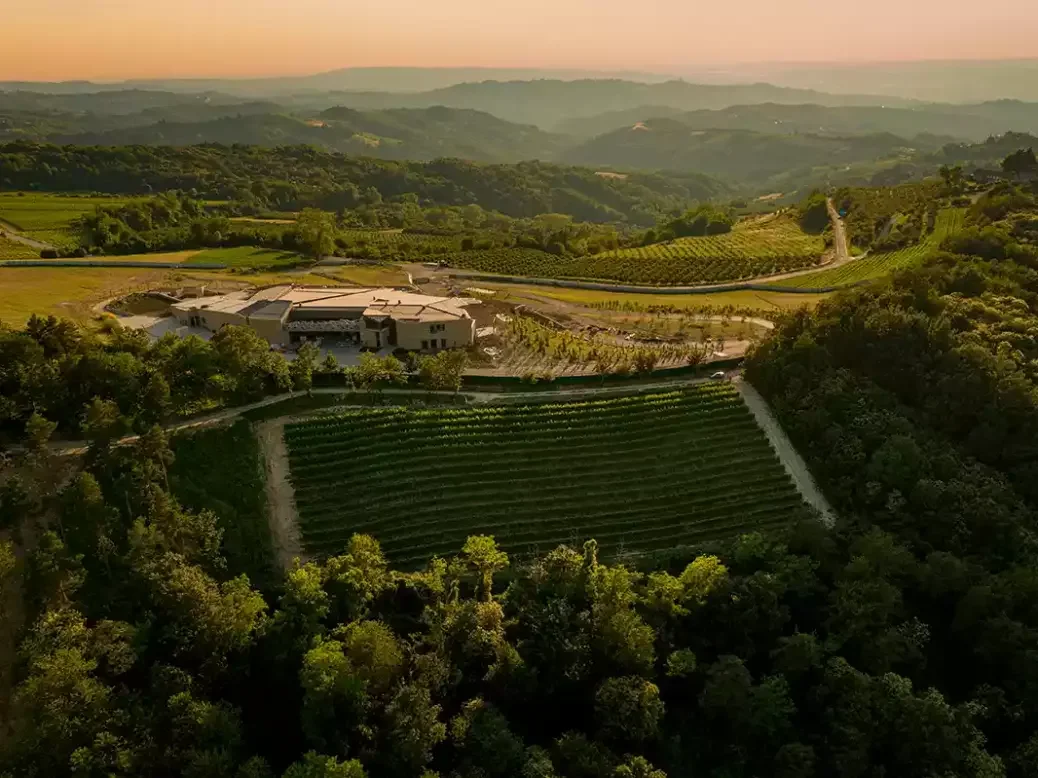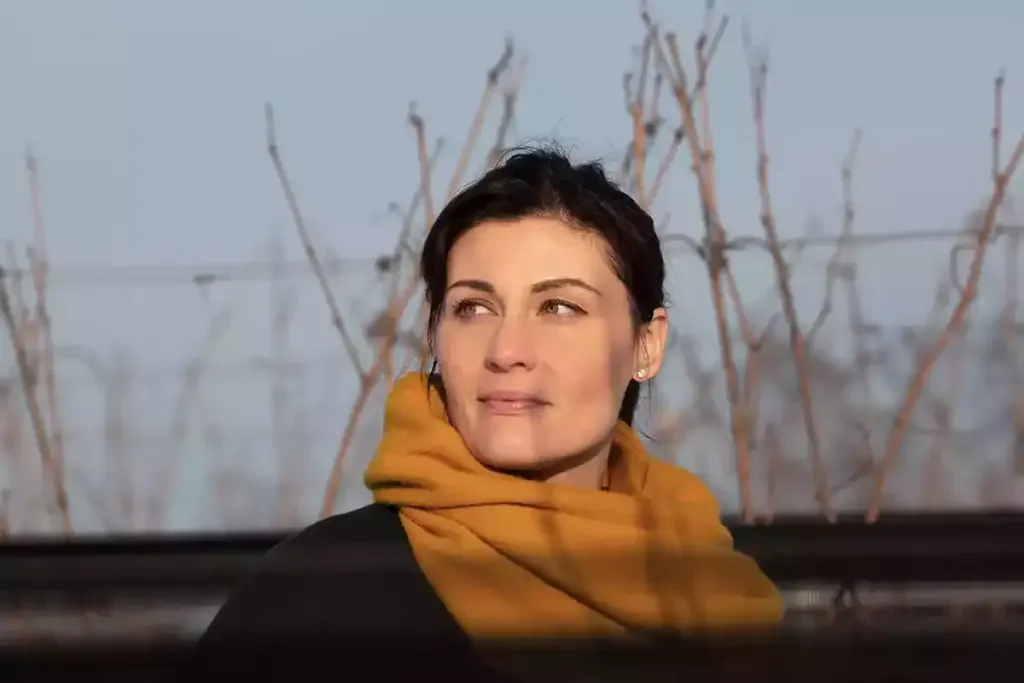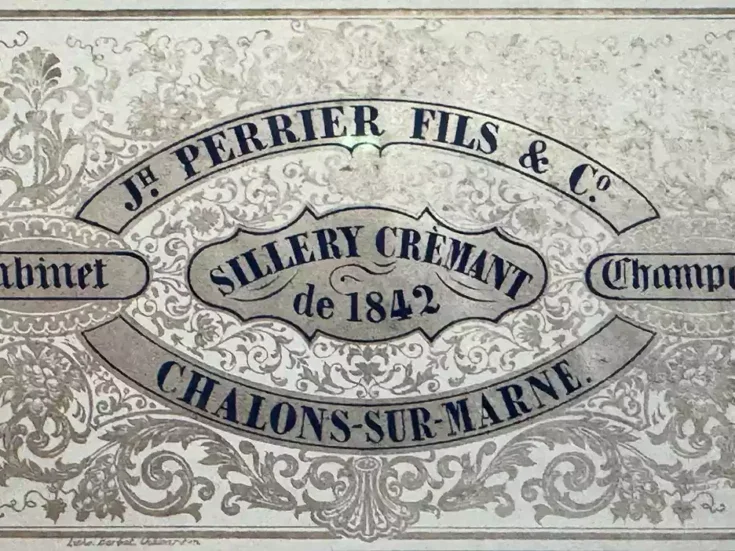
Susan Hulme MW visits Alta Langa to taste through the latest whites from Gaja, including the first from the new vineyards and winery.
We see a future here,” says Gaia Gaja, reflecting on the purchase of 30ha (75 acres) of hazelnut groves and woodland in Alta Langa in 2015. “We were looking for cooler places, [and] we realized that we had this jewel on our doorstep.” Gaja’s Alta Langa estate is less than 15 minutes’ drive from Barbaresco, but the altitude of the new vineyards rises to 2,100ft (650m). For every 330ft (100m) above sea level, the temperature drops by nearly 2°F (1°C), so it is significantly cooler than Gaja’s vineyards in Treiso (1,000–1,150ft [300–350m]) or Serralunga (1,150–1,250ft [350–380m]). Gaia adds, “We needed to find areas where technological and phenolic ripeness can happen in a balanced way and at the same time.” They were fortunate to find 30ha all in one piece, with the benefit of many different exposures, at an altitude above 2,000ft (600m).
Gaja decided to plant Chardonnay and Sauvignon Blanc here because they already had experience with these grape varieties and thought that some of the fruit could be included in their well-established portfolio of white wines: Gaia & Rey (Chardonnay), Alteni di Brassica (Sauvignon Blanc), and Rossj-Bass (Chardonnay/Sauvignon Blanc). If climate change continues on its current trajectory, the Alta Langa estate may eventually become the main source of white wines for Gaja—but rather than the sparkling wine that is typical of Alta Langa, their own focus would continue to be still wines.
In early December 2023, I tasted with Gaia, senior Gaja enologist Alessandro Albarello, and their winemaker Marco Penna in Alta Langa. The location was their newly built cantina (opened in August 2023) in Trezzo Tinella. This was a tasting with a difference, because we agreed to taste blind so as to focus only on what we discovered in the glass, looking in particular for any differences resulting from the terroir rather than from the winemaking.
The first three samples offered were Sauvignon Blanc from the 2023 vintage; these were not yet finished wines, but the differences they showed were fascinating. The first wine had less intense, less precise aromas but was fuller, rounder, and more sumptuous on the palate. I assumed that this was from a warmer site and therefore from a Barolo vineyard; it was actually from the Masué vineyard in Barbaresco, which Gaia confirmed is warmer than their Barolo site. The second wine was more assertive and leaner, with a striking acidity, suggesting a cooler location. This wine was from Vivaldo, their new north-facing vineyard surrounded by woods in Serralunga, Barolo.
In the third wine, the aromas of crisp, green apple were much more focused and vivid; then on the palate, the acidity was juicy and bright but not at all harsh—rather, it was better integrated and more refined than in the other two wines. The brightness of the aromas and flavors was much more intense, as if someone had suddenly switched from monochrome to color, and it had a chalkier, longer finish. The grapes for this wine came from the Serra Pini vineyards in the Alta Langa. Given the higher altitude, I was expecting the wines to be crisp, cool, and sharp, with a touch of greener fruit, so I was surprised to find that the acidity was so soft. Alessandro initially wondered whether the acidity in the Alta Langa wines was gentler or “sweeter” because of higher levels of succinic acid developed during the fermentation, but comparative tests have not so far substantiated the theory, and he is intrigued that there seems to be some other reason for what is a very clear perception in taste terms.
We then blind-tasted three Chardonnays from three different locations: first, from Campo Grande in Serralunga; second, Chardonnay Serra Pini from Alta Langa; and third, Chardonnay from the Giacosa vineyard in Treiso. Again, I found the best-integrated, ripest acidity—as well as the chalkiest, most savory finish—on the wine from Alta Langa.
The tasting ended with the Alteni di Brassica Sauvignon Blancs from 2019 to 2022. The 2019 had no Alta Langa fruit, the 2020 had 10 percent, and in 2021 and 2022 it was 20 percent. Again, the wines from 2021 and 2022 were more intense, with greater energy, luminosity, and length.
Gaia commented, “In 2015, we did not have a definite plan, but […] we understood that it was important to go higher.” If their main objective is to achieve a longer, slower ripening period that enables the physical and phenological ripeness of the grapes to occur closer in time, their idea to go higher has had an added bonus of delivering more vibrant, vivid aromas and flavors and a greater harmony on the palate.

Tasting Gaja white wines
Tasted in Trezzo Tinella, December 2023
Alteni di Brassica 2019
A youthful, very pale, silvery lemon color, with delicate aromas of lightly spicy, citrus fruits soaked in tonic water. Lime, lemon, and orange mingle on the nose and begin to change, becoming more quinine-like, flinty, and minerally. On the palate, the flavors are bright and vibrant citrus, with a very appealing, lingering chalkiness on the finish. The acidity is nicely integrated, and there is a considerable range and complexity of flavor. Five percent of the fruit comes from Alta Langa, and 80% of it was fermented in large botti. 2023–33. | 94
Alteni di Brassica 2021
This is the first vintage where 20% of the fruit comes from the new Alta Langa estate Serra Pini. 80% of this wine was fermented and matured in large botti, 5% in tonneaux, and the rest in stainless steel. The wine opens with an explosion of bright green aromas—freshly cut grass and elderflower—very intense and typical of Sauvignon Blanc. There is also a slight, flinty/gun-metal note of reduction, in keeping with this vibrant, full-throttle style. The palate has flavors of green pepper and zesty lime, crunchy Granny Smith apple, and spicy bitter lemon. The acidity is lively and mouthwatering, but it feels ripe and well integrated into the wine and is balanced by a soft, rounded texture. It is brimming with brightness, both pungent and vibrant at the same time. Gaia Gaja called it a little punk in style when we tasted it together. It certainly packs a punch. 2025–35. | 95+
Gaia & Rey Chardonnay 2019
At four years old, this is already showing some development in color and aroma, with a medium-deep, golden-toned lemon appearance. On the nose, gentle notes of honey, cream, and a touch of butter mingled with spice and nut aromas. Round, soft, and honeyed, this has quite a rich, silky texture but contrasting bright apple fruit and crunchy green flavors, with a hint of vanilla. It’s a little bit Chablis-like, but the riper aromas seem to come from a warmer, sunnier place, in contrast to the palate. This wine was fermented and aged for 18 months—60% in large botti, 40% in tonneaux and barriques—and 30% went through malolactic fermentation. It contains no Alta Langa fruit. 2023–35. | 95
Gaia & Rey Chardonnay 2021
Three years younger than the 2019, this 2021 has a much more youthful, pale-green lemon tone. The aromas are lively, transparent, and very clear. There is a creamy, leesy flavor and texture and a fullness on the palate, with bright green apple, zesty lemon, and a touch of chalky minerality. On the palate, the 2021 feels richer and denser in texture and weight than the 2019. I like this tight, taut, and more youthful quality, together with the ripeness of its green flavors—almost like very ripe green apples, with a touch of peach. The acidity is fresh but not green and is beautifully integrated. The wine finishes with an appealing, salty, sea-shell-like minerality. Energetic and bright in style, with lovely concentration and depth of flavor. Very impressive. The 2021 Gaia & Rey was fermented and aged in wood for 18 months, but this time the proportion of larger oak botti was increased to 70%, with only 30% of the wine aged in tonneaux and barriques, and twice as much of the wine—60%—went through malolactic. Tasting both the 2019 and 2021 Gaia & Rey side by side at home with the luxury of time, the 2021 feels so much more vibrant and energetic. Again, there is no Alta Langa fruit in this wine. 2025–45. | 96
Rossj-Bass 2022
This has a wonderful opening fragrance of orange flowers and orange zest and freesia-like spice. It is very charming and appealing on the nose, in a lightly fragrant yet persistent way. On the palate, there are contrasting tangy, crunchy gooseberry and green-herb flavors, encased in a medium-bodied wine with fresh acidity and a moderate finish. The 2022 Rossj-Bass has 10% fruit from Alta Langa, and 40% of this wine was fermented in stainless steel, with 35% in large botti and the rest in tonneaux and barriques. 2024–28. | 92






